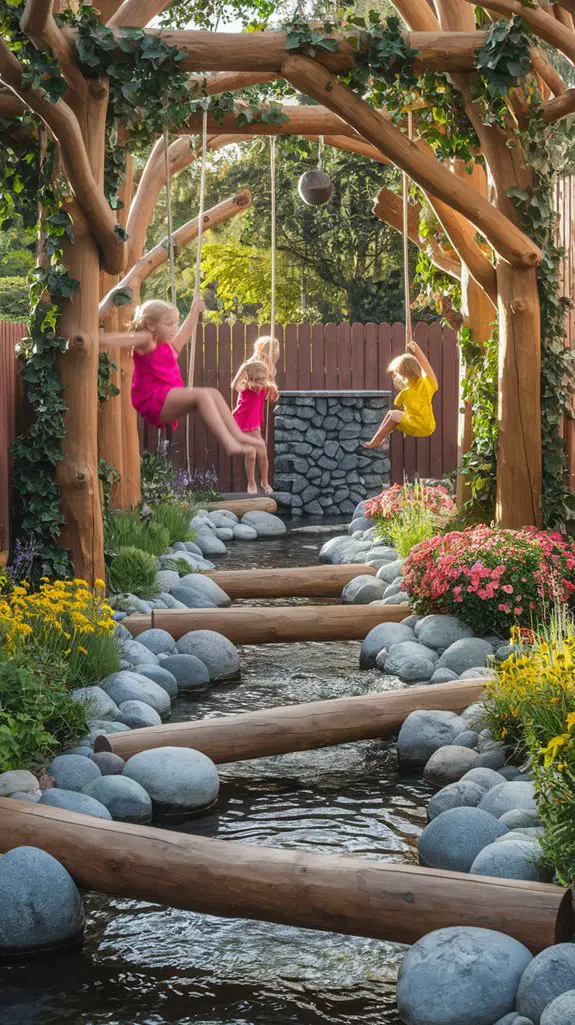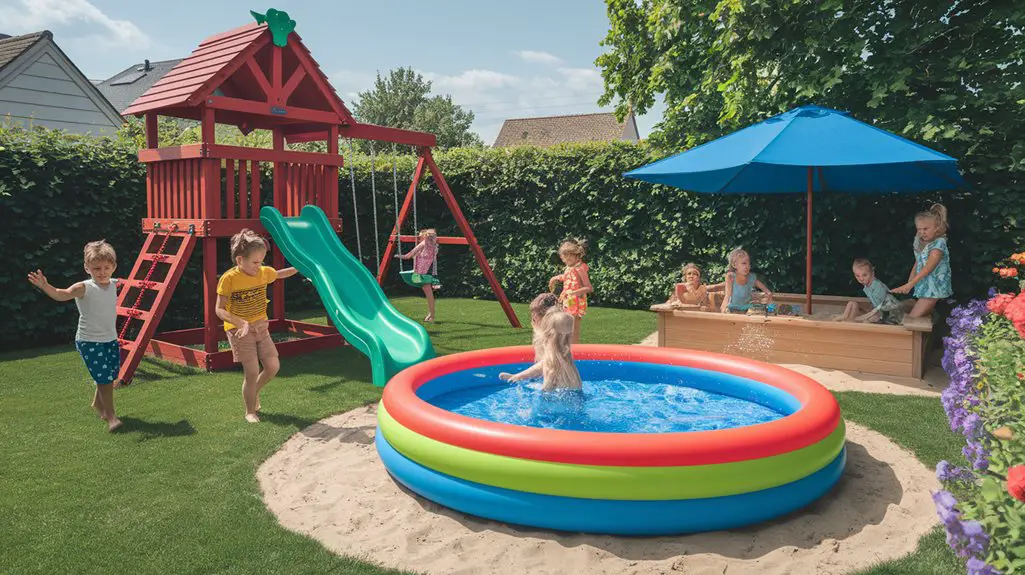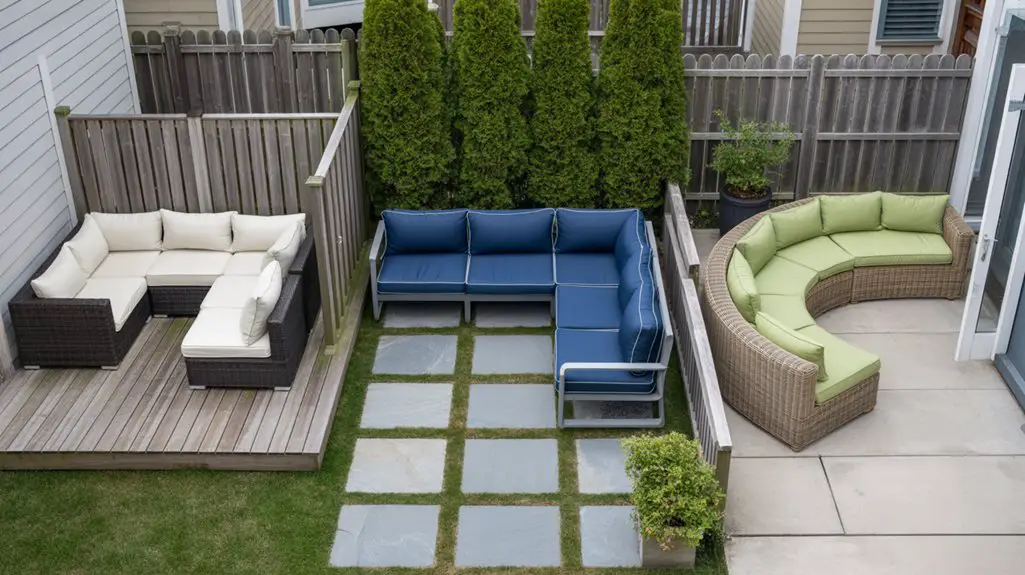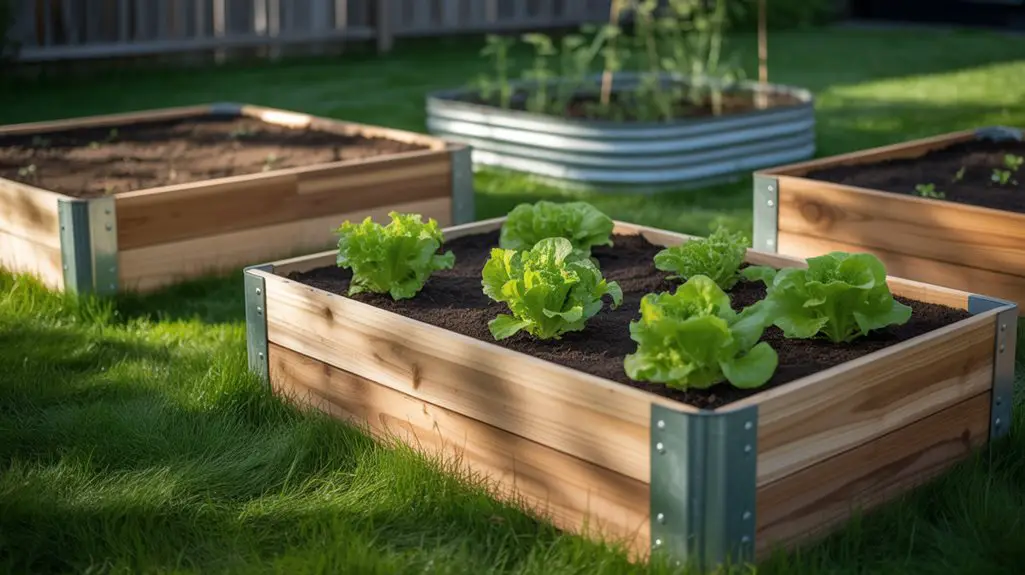Your backyard can become a childhood wonderland with the right play elements. You’ll find that thoughtfully designed outdoor spaces inspire hours of active play and development. Water features offer cooling fun on hot days, while natural adventure zones encourage exploration and physical challenges. Simple DIY obstacle courses can get the whole family moving together, and sensory gardens engage all the senses. What child-friendly activities might transform your outdoor space into their favorite destination?
Water Play Features That Make a Splash
When summer temperatures soar, water play features turn your backyard into a rejuvenating oasis for children of all ages. Simple sprinklers provide endless running and jumping opportunities, while splash pads offer safe water fun without the drowning risks of pools.
Consider installing a water table for toddlers to develop fine motor skills through pouring and splashing activities. For older children, water balloon stations or DIY slip-and-slides encourage physical activity and coordination.
You’ll find that adding water walls—vertical surfaces with funnels, tubes, and water wheels—promotes STEM learning through cause-and-effect experimentation. Engaging play area layouts can also enhance the overall play experience, making the backyard even more inviting for creative exploration.
Whatever you choose, guarantee proper drainage and slip-resistant surfaces. Don’t forget to provide shade options and regular sunscreen application breaks.
These thoughtful water features will create memorable summers while supporting your child’s physical and cognitive development.
Natural Adventure Zones for Exploration

While water play offers invigorating fun, natural adventure zones tap into children’s innate curiosity about the world around them.
These thoughtfully designed spaces encourage your child to explore, discover, and connect with nature in your own backyard.
You’ll find these natural elements create meaningful experiences for children of all ages:
- Rock gardens and stepping stones – Develop balance, coordination, and risk assessment skills
- Log rounds and stumps – Perfect for climbing, jumping, and imaginative play scenarios
- Native plant exploration areas – Introduce science concepts through observation of butterflies, birds, and seasonal changes
- Digging patches – Allow sensory exploration and early understanding of geology concepts
Incorporating the right plants can enhance your wildlife haven, attracting various species that enrich the outdoor experience.
Your natural adventure zone needn’t be elaborate—even simple elements invite wonder and discovery while building confidence through self-directed exploration.
DIY Obstacle Courses for Active Children

Transforming your backyard into a DIY obstacle course offers energetic children the perfect outlet for burning excess energy while developing essential motor skills.
You’ll find this activity adaptable for various ages, with simple modifications to increase or decrease difficulty.
Start with common household items: pool noodles create hurdles, old tires become stepping stones, and a plank across cinder blocks makes a balance beam.
Include crawling sections under stretched ropes, jumping zones marked by hula hoops, and a water station for cooling off.
Time your children as they complete the course, encouraging them to beat their personal records. This builds perseverance and confidence.
Remember to supervise younger participants while allowing older kids the independence to create their own course variations, fostering creativity alongside physical development. Additionally, incorporating age-appropriate challenges can further enhance their engagement and skill development.
Sensory Gardens That Stimulate Discovery
A sensory garden invites children to explore their world through all five senses, creating a magical space where learning happens naturally through discovery.
You’ll provide endless opportunities for your little ones to connect with nature while developing essential cognitive and motor skills.
Create your backyard sensory wonderland by incorporating:
- Touch stations with different textures – smooth stones, fuzzy lamb’s ear plants, rough tree bark, and silky ornamental grasses
- Sound elements like wind chimes, bamboo water features, and tall grasses that rustle in the breeze
- Fragrant plants including lavender, mint, rosemary, and lemon balm that release scents when gently touched
- Taste experiences through safe edible plants like strawberries, cherry tomatoes, and sweet peas
You’ll watch your children blossom as they gain confidence exploring their environment through multisensory play. Additionally, incorporating a backyard play area for sensory development can further enhance their learning experience.
Creative Art Stations for Outdoor Expression
Bringing artistic expression outdoors creates a freeing environment where children can release their creativity without the worry of indoor messes. You’ll find that outdoor art stations encourage sensory exploration while developing fine motor skills and imagination. Additionally, incorporating wildlife-friendly plants into the garden can enhance the overall experience, promoting wildlife-friendly garden interactions.
| Age Group | Art Materials | Setup Ideas |
|---|---|---|
| 2-4 years | Washable paints, sidewalk chalk, finger paints | Low tables, ground tarps, vertical boards |
| 5-7 years | Watercolors, clay, nature materials | Easels, creation tables, collection baskets |
| 8+ years | Mixed media, recyclables, natural dyes | Project stations, drying racks, inspiration boards |
Consider adding weatherproof storage bins for supplies and clotheslines for hanging wet artwork. You can rotate materials seasonally, incorporating elements from your yard like leaves, flowers, and stones to connect art with nature exploration.
Imaginative Play Structures Beyond Swingsets
While traditional swingsets offer classic fun, imaginative play structures reveal a world of possibilities for children to develop cognitive and social skills through pretend play.
These creative alternatives encourage your child to explore different roles and scenarios in your own backyard.
Consider adding these imagination-sparking structures:
- A playhouse or fort that transforms into a shop, castle, or spaceship
- Balance beams and stepping stones that become treacherous lava paths
- A backyard stage with simple curtains for performances and storytelling
- Sensory walls with items to manipulate, turn, and explore
You’ll notice your child’s language development flourish as they narrate adventures and negotiate with playmates. Engaging in exciting backyard games encourages teamwork and physical activity, further enhancing their overall development.
These structures adapt to various ages, growing with your child’s evolving imagination and developmental needs.
Seasonal Games That Transform Your Backyard
Seasonal changes provide perfect opportunities to reinvent your backyard space with games that match the weather and natural elements at hand.
In summer, transform your lawn into a splash zone with sprinkler races or set up a garden scavenger hunt where children identify plants and insects.
Fall invites leaf pile jumping competitions and nature art projects using collected acorns and colorful leaves.
Winter’s snow becomes the perfect medium for building forts, creating snow painting canvases with food coloring, or designing obstacle courses.
Spring welcomes puddle-jumping contests and mud kitchen play that encourages sensory development.
Incorporating multi-age play areas allows family members of all ages to join in the fun, fostering connections and teamwork.
Keep a seasonal activity box ready with supplies like sidewalk chalk, bubbles, or snow molds to quickly adapt your play space as weather shifts, ensuring your children’s outdoor engagement continues year-round.
Child-Friendly Gardening Spaces That Teach
Creating a dedicated gardening space for children transforms an ordinary backyard into an outdoor classroom where learning happens naturally through hands-on discovery.
You’ll spark curiosity and foster responsibility as your little ones connect with nature in meaningful ways. Developing your child’s green thumb through fun vegetable gardening ideas can enhance their interest in growing their own food.
Develop your child’s green thumb with these age-appropriate gardening elements:
- Raised beds at child height – Make tending plants accessible even for toddlers, allowing them to reach without frustration.
- Child-sized tools – Provide real (not toy) gardening equipment scaled for small hands.
- Quick-growing plants – Choose seeds like radishes, sunflowers, and lettuce that show results within days.
- Sensory elements – Incorporate fragrant herbs, textured plants, and edible flowers that engage multiple senses.
Include a dedicated digging area where they can freely explore soil properties while keeping your prized plants protected.
Conclusion
Your backyard is a canvas brimming with possibilities where childhood memories bloom like wildflowers. By incorporating these play zones, you’ve created a world where your little ones can spread their wings and soar through development. Don’t wait for tomorrow—start transforming your outdoor space today. As seasons change, your child’s playground will evolve, nurturing their growing minds and bodies through the magic of play.




